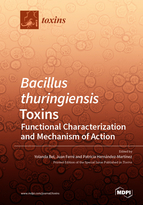Bacillus thuringiensis Toxins: Functional Characterization and Mechanism of Action
A special issue of Toxins (ISSN 2072-6651). This special issue belongs to the section "Bacterial Toxins".
Deadline for manuscript submissions: closed (30 June 2020) | Viewed by 83581
Special Issue Editors
Interests: research on new Bt strains and their insecticidal and nematocidal protein genes for the development of new Bt-based strategies to control agricultural pests; biochemical and genetic bases of resistance to Bacillus thuringiensis (Bt) and mode of action of its proteins; molecular markers of Bt resistance genes
Special Issues, Collections and Topics in MDPI journals
Interests: understanding the biochemical and genetic bases of insect resistance to Bacillus thuringiensis toxins; to study the mode of action of Vip3 insecticidal proteins
Special Issues, Collections and Topics in MDPI journals
Interests: understanding the mechanisms by which Bacillus thuringiensis toxins exert their toxicity (mode of action), and how insects can develop resistance to them; understanding the response mechanisms of insects to B. thuringiensis proteins exposure
Special Issues, Collections and Topics in MDPI journals
Special Issue Information
Dear Colleagues,
Bacillus thuringiensis (Bt)-based products are the most successful microbial insecticides to date. This entomopathogenic bacterium produces different kinds of proteins whose specific toxicity has been shown against a wide range of insect orders, nematodes, and human-cancer cells. Some of these proteins are accumulated in parasporal crystals during the sporulation phase (Cry and Cyt proteins), whereas other proteins are secreted in the vegetative phase of growth (Vip and Sip toxins). Currently, insecticidal proteins belonging to different groups (Cry and Vip3 proteins) are widely used to control insect pests and vectors both in formulated sprays and in transgenic crops (the so-called Bt-crops). Despite the extensive use of these proteins in insect pest control, especially Cry and Vip3, their mode of action is not completely understood.
The aim of this Special Issue is to gather information that could expand the knowledge of the structure and function of Bt proteins, as well as to shed light on their mode of action, especially regarding the insect receptors. We will consider papers focusing on the steps that are still blurred within the mode of action of the better known Bt insecticidal proteins (the 3-domain Cry proteins), or those addressing the mode of action of the lesser-known Bt proteins (such as Vip3 proteins, binary Cry toxins, and Mtx-like toxins). In addition, studies on the functional characterization of the Bt proteins with the aim to develop strategies to improve their toxicity, or mini reviews on the current knowledge on any of the mentioned topics, will also be welcomed.
Dr. Yolanda Bel
Dr. Patricia Hernández-Martínez
Prof. Dr. Juan Ferré
Guest Editors
Manuscript Submission Information
Manuscripts should be submitted online at www.mdpi.com by registering and logging in to this website. Once you are registered, click here to go to the submission form. Manuscripts can be submitted until the deadline. All submissions that pass pre-check are peer-reviewed. Accepted papers will be published continuously in the journal (as soon as accepted) and will be listed together on the special issue website. Research articles, review articles as well as short communications are invited. For planned papers, a title and short abstract (about 100 words) can be sent to the Editorial Office for announcement on this website.
Submitted manuscripts should not have been published previously, nor be under consideration for publication elsewhere (except conference proceedings papers). All manuscripts are thoroughly refereed through a double-blind peer-review process. A guide for authors and other relevant information for submission of manuscripts is available on the Instructions for Authors page. Toxins is an international peer-reviewed open access monthly journal published by MDPI.
Please visit the Instructions for Authors page before submitting a manuscript. The Article Processing Charge (APC) for publication in this open access journal is 2700 CHF (Swiss Francs). Submitted papers should be well formatted and use good English. Authors may use MDPI's English editing service prior to publication or during author revisions.
Keywords
- mode of action
- bacterial toxins
- cry proteins
- vip proteins
- insecticidal proteins
- Bt protein structure
- protein mutagenesis
- binding to receptors
- oligomer formation
- intracellular signaling








